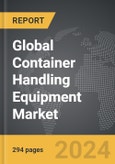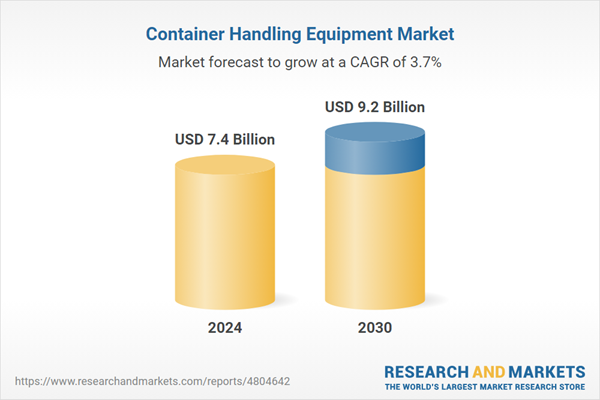The global market for Container Handling Equipment was valued at US$7.4 Billion in 2024 and is projected to reach US$9.2 Billion by 2030, growing at a CAGR of 3.7% from 2024 to 2030. This comprehensive report provides an in-depth analysis of market trends, drivers, and forecasts, helping you make informed business decisions. The report includes the most recent global tariff developments and how they impact the Container Handling Equipment market.
Segments: Equipment Type (Ship-to-Shore Cranes, Automatic Stacking Cranes, Empty Container Handling Forklift Trucks, Laden Forklift Trucks, Mobile Harbor Cranes, Rail-Mounted Gantry Cranes, Rubber-Tired Gantry Cranes, Other Equipment Types); Propulsion (Diesel, Electric, Hybrid).
Geographic Regions/Countries: World; United States; Canada; Japan; China; Europe (France; Germany; Italy; United Kingdom; Spain; Russia; and Rest of Europe); Asia-Pacific (Australia; India; South Korea; and Rest of Asia-Pacific); Latin America (Argentina; Brazil; Mexico; and Rest of Latin America); Middle East (Iran; Israel; Saudi Arabia; United Arab Emirates; and Rest of Middle East); and Africa.
The analysts continuously track trade developments worldwide, drawing insights from leading global economists and over 200 industry and policy institutions, including think tanks, trade organizations, and national economic advisory bodies. This intelligence is integrated into forecasting models to provide timely, data-driven analysis of emerging risks and opportunities.
Global Container Handling Equipment Market - Key Trends and Drivers Summarized
What Powers Global Trade Behind the Scenes? The Critical Role of Container Handling Equipment
Container handling equipment is essential for the swift and efficient movement of goods around the globe, serving as the muscular arms of the world’s ports and terminals. This equipment includes a variety of machines such as cranes, reach stackers, container handlers, and straddle carriers, each designed to specifically handle cargo containers during the loading, unloading, stacking, and moving processes within the shipping yards. Innovations in this field have closely paralleled the evolution of container shipping itself, evolving to meet the demands of increasingly larger ships and the corresponding need to minimize turnaround times. Today’s equipment is characterized by its robustness, technological integration, and adaptability to handle a range of container sizes and weights, ensuring that the backbone of global trade remains both strong and flexible. As global trade volumes continue to increase, the reliance on these machines to maintain and enhance port throughput capacity is more critical than ever.How Is Technology Revolutionizing Container Handling Equipment?
Technological advancements are dramatically transforming the landscape of container handling equipment. The integration of automation and robotics has been a game changer, enhancing the efficiency and safety of operations. Automated guided vehicles (AGVs) and automated stacking cranes (ASCs) are now commonplace in modern ports, operated via remote control or programmed to follow predetermined paths with little to no human intervention. Moreover, the adoption of IoT and AI technologies allows for real-time data collection and analysis, enabling predictive maintenance, which minimizes downtime by addressing mechanical issues before they lead to failures. The use of big data analytics also aids in optimizing logistics and operational flows within terminals, reducing bottlenecks and improving overall throughput efficiency. These technological enhancements not only boost productivity but also reduce the environmental impact of port operations by lowering emissions and energy use.What Challenges and Opportunities Exist for the Container Handling Equipment Industry?
The container handling equipment industry faces several challenges that also present significant opportunities for growth and innovation. One of the main challenges is the environmental impact of heavy machinery, which is typically powered by diesel engines. This issue has spurred the development of electric and hybrid systems that promise to reduce greenhouse gas emissions and noise pollution. Additionally, the cyclical nature of global trade means that equipment manufacturers must be able to scale their production up or down based on shipping demand, which can be unpredictable due to geopolitical tensions, economic fluctuations, and other factors. On the opportunity side, emerging markets are expanding their port facilities and modernizing existing infrastructure, which increases demand for advanced container handling equipment. Furthermore, as ports compete to accommodate the ever-larger container ships, there is a pressing need to upgrade and automate facilities, creating further opportunities for industry leaders in container handling technology.What Drives the Growth in the Container Handling Equipment Market?
The growth in the container handling equipment market is driven by several factors, including technological innovation, increasing environmental regulations, and the expansion of port infrastructure worldwide. As ports and terminals seek to improve operational efficiency and throughput, there is a significant push towards adopting new technologies such as automation and electrification. This shift is also propelled by stringent environmental regulations that require ports to reduce their carbon footprint and noise levels. Additionally, the growth of e-commerce and the resulting increase in global shipping volumes have necessitated the expansion and enhancement of port facilities, including investments in new container handling equipment. Market growth is also supported by the development of new ports and the expansion of existing ones in emerging economies, where trade volumes are increasing rapidly. These factors collectively fuel the demand for more advanced, efficient, and environmentally friendly container handling solutions, underpinning the market’s expansion.Report Scope
The report analyzes the Container Handling Equipment market, presented in terms of units. The analysis covers the key segments and geographic regions outlined below.Segments: Equipment Type (Ship-to-Shore Cranes, Automatic Stacking Cranes, Empty Container Handling Forklift Trucks, Laden Forklift Trucks, Mobile Harbor Cranes, Rail-Mounted Gantry Cranes, Rubber-Tired Gantry Cranes, Other Equipment Types); Propulsion (Diesel, Electric, Hybrid).
Geographic Regions/Countries: World; United States; Canada; Japan; China; Europe (France; Germany; Italy; United Kingdom; Spain; Russia; and Rest of Europe); Asia-Pacific (Australia; India; South Korea; and Rest of Asia-Pacific); Latin America (Argentina; Brazil; Mexico; and Rest of Latin America); Middle East (Iran; Israel; Saudi Arabia; United Arab Emirates; and Rest of Middle East); and Africa.
Key Insights:
- Market Growth: Understand the significant growth trajectory of the Ship-to-Shore Cranes segment, which is expected to reach US$2.2 Billion by 2030 with a CAGR of a 4.0%. The Automatic Stacking Cranes segment is also set to grow at 4.3% CAGR over the analysis period.
- Regional Analysis: Gain insights into the U.S. market, valued at $2.0 Billion in 2024, and China, forecasted to grow at an impressive 6.3% CAGR to reach $1.9 Billion by 2030. Discover growth trends in other key regions, including Japan, Canada, Germany, and the Asia-Pacific.
Why You Should Buy This Report:
- Detailed Market Analysis: Access a thorough analysis of the Global Container Handling Equipment Market, covering all major geographic regions and market segments.
- Competitive Insights: Get an overview of the competitive landscape, including the market presence of major players across different geographies.
- Future Trends and Drivers: Understand the key trends and drivers shaping the future of the Global Container Handling Equipment Market.
- Actionable Insights: Benefit from actionable insights that can help you identify new revenue opportunities and make strategic business decisions.
Key Questions Answered:
- How is the Global Container Handling Equipment Market expected to evolve by 2030?
- What are the main drivers and restraints affecting the market?
- Which market segments will grow the most over the forecast period?
- How will market shares for different regions and segments change by 2030?
- Who are the leading players in the market, and what are their prospects?
Report Features:
- Comprehensive Market Data: Independent analysis of annual sales and market forecasts in US$ Million from 2024 to 2030.
- In-Depth Regional Analysis: Detailed insights into key markets, including the U.S., China, Japan, Canada, Europe, Asia-Pacific, Latin America, Middle East, and Africa.
- Company Profiles: Coverage of players such as Anhui HeLi Co., Ltd., CVS ferrari S.P.A, Hoist Liftruck Mfg., LLC, Hyster-Yale Materials Handling, Inc., Kalmar and more.
- Complimentary Updates: Receive free report updates for one year to keep you informed of the latest market developments.
Some of the 41 companies featured in this Container Handling Equipment market report include:
- Anhui HeLi Co., Ltd.
- CVS ferrari S.P.A
- Hoist Liftruck Mfg., LLC
- Hyster-Yale Materials Handling, Inc.
- Kalmar
- Konecranes Plc
- Liebherr-International Deutschland GmbH
- Lonking Machinery Co., Ltd.
- Sany Group
- Shanghai Zhenhua Heavy Industries Co., Ltd. (ZPMC)
Tariff Impact Analysis: Key Insights for 2025
Global tariff negotiations across 180+ countries are reshaping supply chains, costs, and competitiveness. This report reflects the latest developments as of April 2025 and incorporates forward-looking insights into the market outlook.The analysts continuously track trade developments worldwide, drawing insights from leading global economists and over 200 industry and policy institutions, including think tanks, trade organizations, and national economic advisory bodies. This intelligence is integrated into forecasting models to provide timely, data-driven analysis of emerging risks and opportunities.
What’s Included in This Edition:
- Tariff-adjusted market forecasts by region and segment
- Analysis of cost and supply chain implications by sourcing and trade exposure
- Strategic insights into geographic shifts
Buyers receive a free July 2025 update with:
- Finalized tariff impacts and new trade agreement effects
- Updated projections reflecting global sourcing and cost shifts
- Expanded country-specific coverage across the industry
Table of Contents
I. METHODOLOGYII. EXECUTIVE SUMMARY2. FOCUS ON SELECT PLAYERSIII. MARKET ANALYSISCANADAITALYSPAINRUSSIAREST OF EUROPESOUTH KOREAREST OF ASIA-PACIFICARGENTINABRAZILMEXICOREST OF LATIN AMERICAIRANISRAELSAUDI ARABIAUNITED ARAB EMIRATESREST OF MIDDLE EASTIV. COMPETITION
1. MARKET OVERVIEW
3. MARKET TRENDS & DRIVERS
4. GLOBAL MARKET PERSPECTIVE
UNITED STATES
JAPAN
CHINA
EUROPE
FRANCE
GERMANY
UNITED KINGDOM
ASIA-PACIFIC
AUSTRALIA
INDIA
LATIN AMERICA
MIDDLE EAST
AFRICA
Companies Mentioned (Partial List)
A selection of companies mentioned in this report includes, but is not limited to:
- Anhui HeLi Co., Ltd.
- CVS ferrari S.P.A
- Hoist Liftruck Mfg., LLC
- Hyster-Yale Materials Handling, Inc.
- Kalmar
- Konecranes Plc
- Liebherr-International Deutschland GmbH
- Lonking Machinery Co., Ltd.
- Sany Group
- Shanghai Zhenhua Heavy Industries Co., Ltd. (ZPMC)
Table Information
| Report Attribute | Details |
|---|---|
| No. of Pages | 294 |
| Published | April 2025 |
| Forecast Period | 2024 - 2030 |
| Estimated Market Value ( USD | $ 7.4 Billion |
| Forecasted Market Value ( USD | $ 9.2 Billion |
| Compound Annual Growth Rate | 3.7% |
| Regions Covered | Global |









